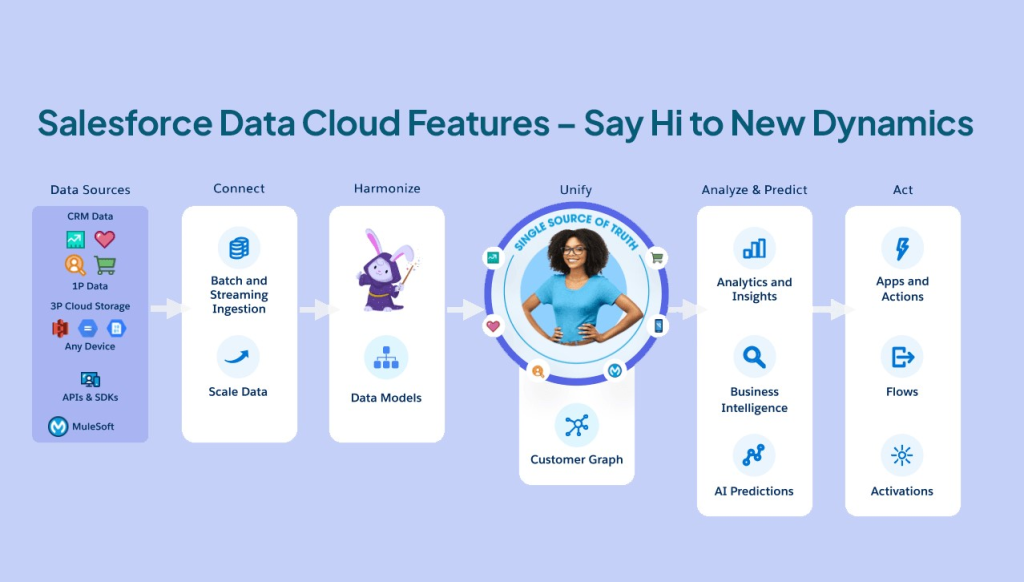
Salesforce Data Cloud ease down your journey to manage customer profile. Now, you have a chance to explore everything under one roof. Integrate it seamlessly with other clouds too. let’s find out everything in detailed with this first blog of “Salesforce Data Cloud” Series.
Do you want to bring real-time magic to your business? If your answer is yes, then Salesforce Data Cloud will be the right pick for you. Earlier, it was known as Genie or CDP (Customer Data Platform) but now, it has some exclusive functionality that will bring a great show down of customer journey. Businesses can now greet their customers more promptly than earlier.
Salesforce data cloud is here to bring an advanced experience to the user. But how? The answer is simple as it harmonizes and unifies the data to get a single source of truth. Also, it enables the business to understand the business & doesn’t bring a feel of numbers only. Real-time data brings a lot more to your business.
Now meeting your customers’ expectations is easy and simple. Businesses can get a unified profile of the customers from multiple platforms and don’t need to dig out much as everything is stored and available at one place. Say Thanks to Data Cloud.
So, we have now understood basics and simple aspects about data cloud. Now we need to move further and need to know how it will help the other clouds.
Salesforce Data Cloud Features – Say Hi to New Dynamics
So, before heading up to the link of Salesforce data cloud with other clouds (Sales, Service, Marketing, Commerce and others), we need to depict the exclusive features of it. Well, it’s a right time to say HI to the future of customer world:
- Data cloud enable you to unify customers profile and work on distinct touchpoints
- Use insights and analytics for building smarter segmentation
- Get started with data from different data lakes and warehouses
- Data ingestion services enable you to capture and unify profile from various platforms
- Add some power of tableau and marketing cloud intelligence
Well, these aspects only work with the right and relevant connection among various data lakes and warehouses. So, let’s understand how it works:

- Step 1 – Data Cloud enables you to plan your strategy and deploy it at a place to unify information at one place.
- Step 2 – Data ingestion is the next step, here we need to deploy connector and connect it with various data lakes and warehouses.
- Step 3 – Once data is ingested, it brings us a 360 Degree view of each customer & unify their profile as well.
- Step 4 – Now with the available data, you can start getting insights and analytics which enable the marketers to understand the behavior.
- Step 5 – Further, you have AI models – so connect them with Salesforce Data Cloud and start making an active and appropriate response for the customer.
- Step 6 – The AI Tool and Salesforce Data Cloud enable you to segmentize the customers and start acting on the available data – like reaching existing customers about a product, or asking about the checkout of the product etc.
- Step 7 – Once you act on data, start analyzing the data by integrating it with Marketing Cloud Intelligence and Tableau for smart decision.
Salesforce Data Cloud – A Unified View of Your Customer Data
Salesforce Data Cloud is a customer data platform (CDP) that helps businesses unify, cleanse, and enrich their customer data from all sources. It provides a single view of each customer, including their interactions with your company across all channels, such as your website, social media, and email.
Data Cloud can be integrated with other Salesforce clouds, such as Sales Cloud, Service Cloud, Marketing Cloud, and Commerce Cloud, to provide a seamless customer experience. For example, you can use Data Cloud to create personalized marketing campaigns, provide better customer service, and improve your sales process.
Here are some specific examples of how Data Cloud can be integrated with other Salesforce clouds:
Integration with Sales Cloud
Data Cloud can be integrated with Sales Cloud to provide sales reps with a unified view of their customers. This includes information such as the customer’s contact information, purchase history, and open opportunities. Sales reps can use this information to personalize their interactions with customers and close more deals.
Integration with Service Cloud
Data Cloud can be integrated with Service Cloud to provide customer support agents with a unified view of their customers. This includes information such as the customer’s contact information, support history, and open cases. Customer support agents can use this information to quickly and efficiently resolve customer issues.
Integration with Marketing Cloud
Data Cloud can be integrated with Marketing Cloud to help businesses create personalized marketing campaigns. For example, businesses can use Data Cloud to segment their customer base and send them targeted email campaigns. Businesses can also use Data Cloud to track the performance of their marketing campaigns and make necessary adjustments.
Integration with Commerce Cloud
Data Cloud can be integrated with Commerce Cloud to help businesses provide a better customer experience. For example, businesses can use Data Cloud to personalize the shopping experience for each customer. Businesses can also use Data Cloud to track customer behavior on their website and make recommendations based on their purchase history.
Salesforce Data Cloud is a powerful tool that can help businesses unify and enrich their customer data from all sources. By integrating Data Cloud with other Salesforce clouds, businesses can create a unified view of their customers, improve their sales process, provide better customer service, and personalize their marketing campaigns. But not only these, you can integrate it into many other clouds too. So, be prepared for your journey.
How will you connect different data sources?
Data cloud works perfectly when it integrates with different other lakes and warehouses. The unification and harmonization of data is possible when you connect multiple data sources.
Data cloud offers multiple methods that allow users to connect their data:
- The first and foremost way to connect different data sources is the connector. You have various connectors in place like Marketing Cloud Email Studio, MobilePush, Marketing Cloud Data Extensions, Salesforce CRM, Marketing Cloud Personalization, Common Cloud Storage Providers, Commerce Cloud.
- The second approach is API as Salesforce provides SDK for you to easily integrate and connect your cloud and other data warehouses and lakes with the Salesforce Data Cloud.
- The third element is Mulesoft Anypoint platform.
Ending Note
So, the suggested lines show a simple and clear understanding of the Salesforce Data Cloud. This brief evaluation enables a good and in-depth understanding for the Admin & Developers unit. So, start upgrading your business with the Data Cloud and bring immersive experience to the customers.
